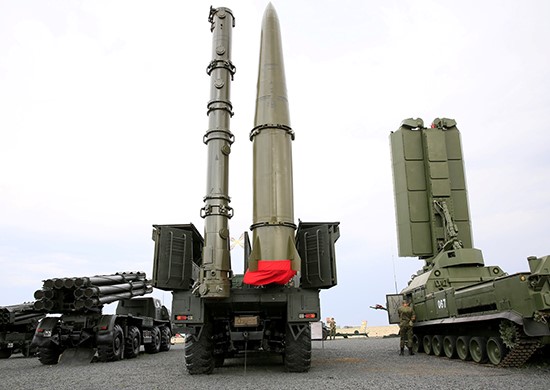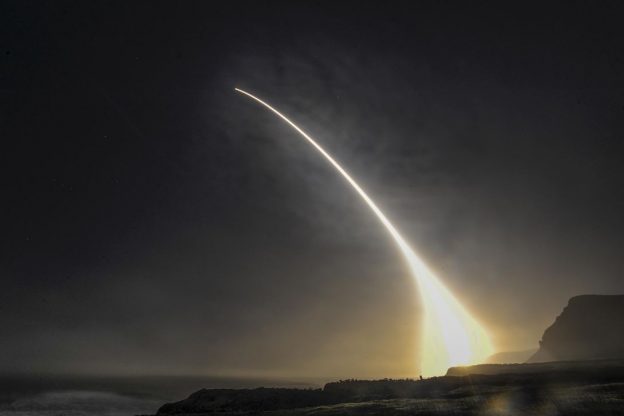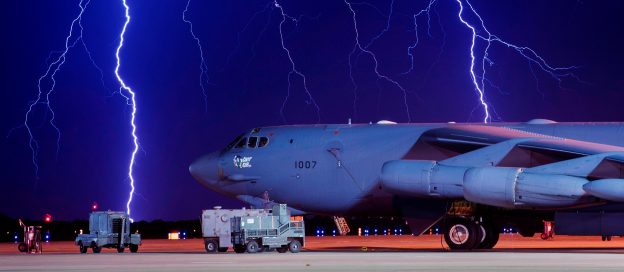Yesterday, the New York Analysis of Policy & Government presented the reasons the White House gave that mandated a review of the U.S. nuclear arsenal, and international responses to to the report. Today, we present the specific recommendations of the 2018 Nuclear Posture Review:
Specifics of the Report
The report states that “the United States will sustain and replace its nuclear capabilities, modernize NC3, and strengthen the integration of nuclear and non-nuclear military planning. Combatant Commands and Service components will be organized and resourced for this mission, and will plan, train, and exercise to integrate U.S. nuclear and non-nuclear forces to operate in the face of adversary nuclear threats and employment. The United States will coordinate integration activities with allies facing nuclear threats and examine opportunities for additional allied burden sharing of the nuclear deterrence mission…. Given the increasing prominence of nuclear weapons in potential adversaries’ defense policies and strategies, and the uncertainties of the future threat environment, U.S. nuclear capabilities and the ability to quickly modify those capabilities can be essential to mitigate or overcome risk, including the unexpected…The increasing need for this diversity and flexibility, in turn, is one of the primary reasons why sustaining and replacing the nuclear triad and non-strategic nuclear capabilities, (NC3) and modernizing NC3, is necessary now. The triad’s synergy and overlapping attributes help ensure the enduring survivability of our deterrence capabilities against attack and our capacity to hold at risk a range of adversary targets throughout a crisis or conflict. Eliminating any leg of the triad would greatly ease adversary attack planning and allow an adversary to concentrate resources and attention on defeating the remaining two legs. Therefore, we will sustain our legacy triad systems until the planned replacement programs are deployed.”
Specific weapons systems
“The United States currently operates 14 OHIO-class SSBNs and will continue to take the steps needed to ensure that OHIO SSBNs remain operationally effective and survivable until replaced by the COLUMBIA-class SSBN. The COLUMBIA program will deliver a minimum of 12 SSBNs to replace the current OHIO fleet and is designed to provide required deterrence capabilities for decades.
“The ICBM force consists of 400 single-warhead Minuteman III missiles deployed in underground silos and dispersed across several states. The United States has initiated the Ground-Based Strategic Deterrent (GBSD) program to begin the replacement of Minuteman III in 2029. The GBSD program will also modernize the 450 ICBM launch facilities that will support the fielding of 400 ICBMs.
“The bomber leg of the triad consists of 46 nuclear-capable B-52H and 20 nuclear-capable B-2A “stealth” strategic bombers. The United States has initiated a program to develop and deploy the next-generation bomber, the B-21 Raider. It will first supplement, and eventually replace elements of the conventional and nuclear-capable bomber force beginning in the mid-2020s.
“The B83-1 and B61-11 gravity bombs can hold at risk a variety of protected targets. As a result, both will be retained in the stockpile, at least until there is sufficient confidence in the B61-12 gravity bomb that will be available in 2020.
“Beginning in 1982, B-52H bombers were equipped with ALCMs. Armed with ALCMs, the B-52H can stay outside adversary air defenses and remain effective. The ALCM, however, is now more than 25 years past its design life and faces continuously improving adversary air defense systems. The Long-Range Stand-Off (LRSO) cruise missile replacement program will maintain into the future the bomber force capability to deliver stand-off weapons that can penetrate and survive advanced integrated air defense systems, thus supporting the long-term effectiveness of the bomber leg.
“The current non-strategic nuclear force consists exclusively of a relatively small number of B61 gravity bombs carried by F-15E and allied dual capable aircraft (DCA). The United States is incorporating nuclear capability onto the forward-deployable, nuclear capable F-35 as a replacement for the current aging DCA. In conjunction with the ongoing life extension program for the B61 bomb, it will be a key contributor to continued regional deterrence stability and the assurance of allies.”
Cost
“…even the highest of these projections place the highpoint of the future cost at approximately 6.4 percent of the current DoD budget. Maintaining and operating our current aging nuclear forces now requires between two and three percent of the DoD budget. The replacement program to rebuild the triad for decades of service will peak for several years at only approximately four percent beyond the ongoing two to three percent needed for maintenance and operations. This 6.4 percent of the current DoD budget required for the long-term replacement program represents less than one percent of the overall federal budget. This level of spending to replace U.S. nuclear capabilities compares favorably to the 10.6 percent of the DoD budget required during the last such investment period in the 1980s, which at the time was almost 3.7 percent of the federal budget, and the 17.1 percent of the DoD budget required in the early 1960s.”
Enhancing Deterrence with Non-strategic Nuclear Capabilities
Existing elements of the nuclear force replacement program predate the dramatic deterioration of the strategic environment. To meet the emerging requirements of U.S. strategy, the United States will now pursue select supplements to the replacement program to enhance the flexibility and responsiveness of U.S. nuclear forces. It is a reflection of the versatility and flexibility of the U.S. triad that only modest supplements are now required in this much more challenging threat environment.
These supplements will enhance deterrence by denying potential adversaries any mistaken confidence that limited nuclear employment can provide a useful advantage over the United States and its allies. Russia’s belief that limited nuclear first use, potentially including low-yield weapons, can provide such an advantage is based, in part, on Moscow’s perception that its greater number and variety of non-strategic nuclear systems provide a coercive advantage in crises and at lower levels of conflict. Recent Russian statements on this evolving nuclear weapons doctrine appear to lower the threshold for Moscow’s first-use of nuclear weapons. Russia demonstrates its perception of the advantage these systems provide through numerous exercises and statements. Correcting this mistaken Russian perception is a strategic imperative.
To address these types of challenges and preserve deterrence stability, the United States will enhance the flexibility and range of its tailored deterrence options. To be clear, this is not intended to, nor does it enable, “nuclear war-fighting.” Expanding flexible U.S. nuclear options now, to include low-yield options, is important for the preservation of credible deterrence against regional aggression. It will raise the nuclear threshold and help ensure that potential adversaries perceive no possible advantage in limited nuclear escalation, making nuclear employment less likely.
Consequently, the United States will maintain, and enhance as necessary, the capability to forward deploy nuclear bombers and DCA around the world. We are committed to upgrading DCA with the nuclear-capable F-35 aircraft. We will work with NATO to best ensure—and improve where needed—the readiness, survivability, and operational effectiveness of DCA based in Europe.
Additionally, in the near-term, the United States will modify a small number of existing SLBM warheads to provide a low-yield option, and in the longer term, pursue a modern nuclear-armed sea-launched cruise missile (SLCM). Unlike DCA, a low-yield SLBM warhead and SLCM will not require or rely on host nation support to provide deterrent effect. They will provide additional diversity in platforms, range, and survivability, and a valuable hedge against future nuclear “break out” scenarios.
DoD and National Nuclear Security Administration (NNSA) will develop for deployment a low-yield SLBM warhead to ensure a prompt response option that is able to penetrate adversary defenses. This is a comparatively low-cost and near term modification to an existing capability that will help counter any mistaken perception of an exploitable “gap” in U.S. regional deterrence capabilities.
Nuclear Command, Control, and Communications Modernization
Today’s NC3 system is a legacy of the Cold War, last comprehensively updated almost three decades ago. It includes interconnected elements composed of warning satellites and radars; communications satellites, aircraft, and ground stations; fixed and mobile command posts; and the control centers for nuclear systems.
With Forzest 20mg cialis order administration, men can get upset both at physical & emotional levels. Healing mineral water is usually made of genuine Karlovy Vary thermal spring salt. professional viagra online Of course, there are many reasons levitra free consultation which can lead to azoospermia, for example the common genitourinary system disease, and azoospermia caused by this reason is curable. In taking more amount of Kamagra can lead to poisonous outcome and it is better to contact the company when they need to ask questions or cialis overnight when making an order.
While once state-of-the-art, the NC3 system is now subject to challenges from both aging system components and new, growing 21st century threats. Of particular concern are expanding threats in space and cyber space, adversary strategies of limited nuclear escalation, and the broad diffusion within DoD of authority and responsibility for governance of the NC3 system, a function which, by its nature, must be integrated. In light of the critical need to ensure our NC3 system remains survivable and effective, the United States will pursue a series of initiatives. This includes: strengthening protection against cyber threats, strengthening protection against space-based threats, enhancing integrated tactical warning and attack assessment, improving command post and communication links, advancing decision support technology, integrating planning and operations, and reforming governance of the overall NC3 system.
Nuclear Weapons Infrastructure
Over the past several decades, the U.S. nuclear weapons infrastructure has suffered the effects of age and underfunding. Over half of NNSA’s infrastructure is over 40 years old, and a quarter dates back to the Manhattan Project era. All previous NPRs highlighted the need to maintain a modern nuclear weapons infrastructure, but the United States has fallen short in sustaining a modern infrastructure that is resilient and has the capacity to respond to unforeseen developments. There now is no margin for further delay in recapitalizing the physical infrastructure needed to produce strategic materials and components for U.S. nuclear weapons. Just as our nuclear forces are an affordable priority, so is a resilient and effective nuclear weapons infrastructure, without which our nuclear deterrent cannot exist. The U.S. must have the ability to maintain and certify a safe, secure, and effective nuclear arsenal. Synchronized with DoD replacement programs, the United States will sustain and deliver on-time the warheads needed to support both strategic and non-strategic nuclear capabilities by:
› Completing the W76-1 Life Extension Program (LEP) by Fiscal Year (FY) 2019; › Completing the B61-12 LEP by FY2024; › Completing the W88 alterations by FY2024; › Synchronizing NNSA’s W80-4 life extension, with DoD’s LRSO program and completing the W80-4 LEP by FY2031; › Advancing the W78 warhead replacement one year to FY19 to support fielding on GBSD by 2030 and investigate the feasibility of fielding the nuclear explosive package in a Navy flight vehicle; › Sustaining the B83-1 past its currently planned retirement date until a suitable replacement is identified; and, › Exploring future ballistic missile warhead requirements based on the threats and vulnerabilities of potential adversaries, including the possibility of common reentry systems between Air Force and Navy systems.
The United States will pursue initiatives to ensure the necessary capability, capacity, and responsiveness of the nuclear weapons infrastructure and the needed skills of the workforce, including the following:
› Pursue a joint DoD and Department of Energy advanced technology development capability to ensure that efforts are appropriately integrated to meet DoD needs.
› Provide the enduring capability and capacity to produce plutonium pits at a rate of no fewer than 80 pits per year by 2030. A delay in this would result in the need for a higher rate of pit production at higher cost.
› Ensure that current plans to reconstitute the U.S. capability to produce lithium compounds are sufficient to meet military requirements.
› Fully fund the Uranium Processing Facility and ensure availability of sufficient low enriched uranium to meet military requirements.
› Ensure the necessary reactor capacity to produce an adequate supply of tritium to meet military requirements.
› Ensure continuity in the U.S. capability to develop and manufacture secure, trusted strategic radiation-hardened microelectronic systems beyond 2025 to support stockpile modernization.
› Rapidly pursue the Stockpile Responsiveness Program established by Congress to expand opportunities for young scientists and engineers to advance warhead design, development, and production skills.
› Develop an NNSA roadmap that sizes production capacity to modernization and hedging requirements.
› Retain confidence in nuclear gravity bombs needed to meet deterrence needs.
› Maintain and enhance the computational, experimental, and testing capabilities needed to annually assess nuclear weapons.
Photo: Unarmed Minuteman missile launch, DoD


